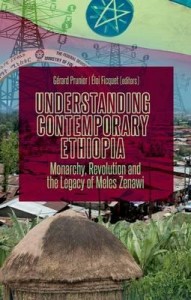|
Reviewed by Mr. Christopher Bailey, National Intelligence University Drs. Gerard Prunier and Eloi Ficquet have edited a comprehensive study that weaves together a broad range of scholarly essays on Ethiopia. The resulting blend of works is engaging and readable, leaving the reader with an in-depth understanding of Ethiopian history, culture and politics. Unique among African nations, she experienced only brief colonial control and was a founding member of the United Nations in 1945. Today, she is an important regional power with the second largest population on the continent, home to the headquarters of the African Union, and often a major supporter to international peacekeeping operations. This book, likely the first major work on the country in over 30 years, even though much has changed since then, is an important contribution to East African studies. I strongly recommend Understanding Contemporary Ethiopia to scholars, students and others with an interest in the Horn of Africa. Prunier and Ficquet are both eminently qualified to write on Ethiopia. Prunier is a well-known Africanist who has authored extensive works on East Africa over the past 30 years. Ficquet is an anthropologist and historian; he has also authored many articles on Ethiopian history and culture. Here, the editors have marshaled a distinguished team of political scientists, historians, anthropologists, an expert in urban development, and a journalist, that has produced 16 wide-ranging essays, each complete with a detailed bibliography that facilitates deep-dive research by the reader. Indeed, Ethiopia’s “ethnic federal” structure, with the country organized since 1994 into nine ethno-linguistically based regional states and two chartered cities, offers a possible political model for other multi-ethnic, multi-sectarian nations striving for a modern national identity in the face of long-standing internal cleavages and animosities. Ethiopia has over 80 ethnic and linguistic groups that have experienced recent social and economic transformation associated with two major regime changes, armed conflict with neighbors and numerous rebel groups, and urban development. One persistent problem involves pan-Somali nationalism, given that ethnic Somalis are the third largest Ethiopian nationality—typically not fully integrated into the Ethiopian nationality—and that the Ethiopian Somalis represent about 30 percent of the overall Somali population spread throughout the region. Ethiopia, once a Christian kingdom and now a secular state since only 1974, also has a deep-rooted religious history, with its own Orthodox Church that traces back to the fourth century AD (the sacred city of Aksum), a large and fast growing Protestant/evangelical (Pente) movement, and a substantial Sunni Muslim minority with a strong Sufi tradition. As a result, Ethiopia faces many competing interests as it navigates through a range of 21st century political, economic, and social problems. Ethiopia has suffered many significant, even existential, political-military threats in recent years, to include a 1974 military coup that resulted in the fall of a monarchy that dated back to the 12th century; a 17-year period of brutal rule by a Marxist military junta (the Derge); a 1961-91 civil war that resulted in independence for Eritrea and left Ethiopia as a land-locked country; the spillover effects from the 1983-2005 conflict in neighboring Sudan over independence for South Sudan; the post 1991 transition to a federal parliamentary republic and a new 1995 Constitution; the 1998-2000 international armed conflict with Eritrea that was sparked by border disputes and later saw the deployment of a UN mission; and the post-2006 fight in Somalia in support of the Somali Transitional Federal Government (TFG) against Islamic (Salafi) militants. In fact, Salafism has become increasingly influential among the ethnic Somalis in Ethiopia’s eastern Oromo region, often supported by Saudi Arabia and raising religious tensions in the area. The recent fighting in Somalia has involved major Ethiopian troop deployments, and has been criticized by human rights organizations for violations of international humanitarian law. Today, Ethiopia experiences periodic terrorism threats, often seen as related to religious fundamentalism having foreign connections, to the border conflicts with Eritrea, to pan-Somali nationalism, or to its on-going support of the African Union Mission in Somalia (AMISOM). And, the 2012 death of Meles Zenawi, the Ethiopian prime minister from 1995-2012 who was a supporter of the United States in the war on terror, leaves the country at a possible turning point. Some see an opportunity for Ethiopia to improve its human rights record, liberalize its economy, and improve political participation by opposition groups. Others express concern about Ethiopia’s role in maintaining peace and security in a conflict-ridden region. On the other hand, critics have hoped for the amnesty of detainees and a relaxation of the repressive 2009 anti-terrorism law that has reportedly decimated the media with politically motivated prosecutions. All this means Ethiopia has faced significant threats to its national security and domestic stability over the past 40 years; there is no doubt many of these threats will plague the country for many coming years. Thus, Understanding Contemporary Ethiopia offers readers an up-to-date and comprehensive examination of an important African political power, offering some insights into the challenges that the country will likely see in the coming years. |


 Understanding Contemporary Ethiopia: Monarchy, Revolution and the Legacy of Meles Zenawi
Understanding Contemporary Ethiopia: Monarchy, Revolution and the Legacy of Meles Zenawi